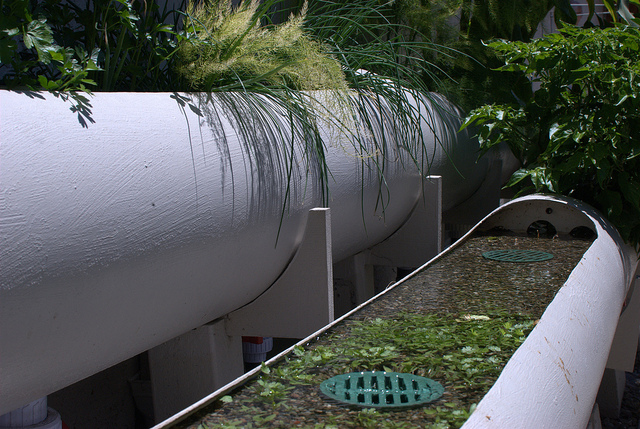This is Page 4 of our eight page series on flood and drain systems. Click any of the below pages to jump to that page.
Page 1 Page 2 Page 3 Page 4 Page 5 Page 6 Page 7 Page 8
Flood and Drain Systems, continued

A pair of homemade flood and drain containers, housing a variety of decorative plants, during the irrigation phase. Notice that the lower container is using gravel as a growing medium. Also notice the very large drains which are just below the edge of the growing container. Such large drains will help ensure that the containers don't overflow. The drain height (in this instance, just above the growing medium) also ensures that the containers fill all the way to the brim with water. That drain height can be varied according to the crop root depth and preference for or sensitivity to waterlogged growing media.
Which Crops Don't Work Well?
Just about every crop I can think of could be made to work with ebb and flow, but as we discussed above there are some plants which might be more practical to grow in other hydroponic setups. For instance, lettuces do very well in ebb and flow setups, yet they are often grown in NFT or raft systems instead. Why? First, NFT is less space intensive and lighter in weight, so the lettuces can be grown in locations where a flood and drain container might be impractical. Second, many commercial growers (and some hobbyist growers too) have extremely tight budgets, and need to minimize the infrastructure. Where flood and drain requires a large sturdy container and growing media of some kind. NFT by comparison only requires a lightweight channel wide enough for each individual plant, and a grow cube to germinate the seed. The roots are then free to develop in the channel without any additional growing media. Additionally, several such channels can be elevated to provide for vertical grow space, thereby making the most of whatever grow space you have. Third, many commercial growers will continuously plant lettuces throughout the season, then harvest the entire plant when it reaches maturity. Harvesting an entire plant from an NFT system is relatively easy; you just lift the pot out of the little hole in the channel, and you're done. With ebb and flow, the entire plant would need to be lifted from growing media which will resist the plant being pulled out. And the removal will disrupt nearby roots from other plants. Finally, beware that sometimes folks just get latched onto a hydroponics system as being "the best" or "the worst" because of their own personal preferences. Bottom line, flood and drain can work well for most plants, most of the time, but personal preferences may favor some other system. That's one of the wonderful things about hydroponics; we have several different systems to choose from. So by all means, use the system which works best for your particular setup AND preferences.
What Growing Media Is used with Flood and Drain Systems?
Theoretically, any type of growing media can potentially be used with flood and drain. However, this will depend in part upon both the germination method used, as well as the crop type itself and whether the crop needs to be transplanted out at a later date. A careful consideration of all those details will help determine which growing media is best for any given application. But the flood and drain system itself doesn't care. It can work with anything, even normal soil.
In practice, some forms of growing media are used a lot more often than others. Sand, gravel, hydroton and lava rock are the most common. Perlite and vermiculite are so lightweight and small in size, that there's a big risk of losing most of the growing media down the drain. Yes a drain filter can be used but it would have to be cleared on almost a daily basis. That hassle means it's not used very often in this system. Coir is not often used for the same reason. Coir, when fresh, has fairly long narrow particle sizes, and as such doesn't float away very easily. However, as it ages it starts to break down, and over time more of it would start to either go down the drain, or clog drain filters. So perlite, vermiculite and coir are not very commonly used in this system.
Rockwool croutons can be used fairly effectively, but rockwool cubes and rockwool slabs are not because they have specific dimensions which would need to be matched by the container size. Rockwool and hydroton are also both more expensive, and the flood and drain system uses more growing media per plant than some other hydroponic systems. So if cost is a concern, go with one of the other growing media types.
Click any of the below links to jump to that page.